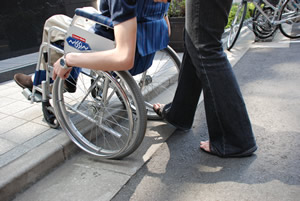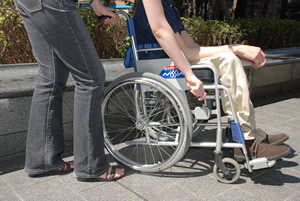What you should know about orthopedic/mobility impairment
1. What is orthopedic/mobility impairment?
Orthopedic impairment is a condition in which the arms, legs, or trunk, including the abdominal, back, pectoral, and leg muscles, are damaged due to illness or injury, resulting in difficulty in daily living such as walking or writing over a prolonged period. Causes include congenital disease, accidents, nerve or brain damage, and joint deformity.
Orthopedic impairment varies widely from individual to individual with the part of the body affected and the degree of severity -- impairment in the leg, arm, or whole body. Some people with orthopedic/mobility impairment find little difficulty in daily living and manage with a cane, wheelchair, or prosthesis. Others may require extensive assistance in daily living.
2. Interacting with individuals with orthopedic impairment
Given the widely differing conditions involved, assistance differs greatly from person to person. For those using a wheelchair or a cane, for example, a small step or slope may become a barrier. Individuals who may have lost or suffered from paralysis of a finger, hand, or arm may have difficulty writing and handling money. Many persons with orthopedic impairment are very able to move around on their own. Check first with the person requiring support exactly what is needed and provide support after confirmation.
Assistance may be provided directly or indirectly. It is important to both lend a helping hand and to anticipate from a distance the support that may be needed.
Refer to the following on how to interact with people who use wheelchairs, canes, or guide dogs and other special-needs animals:
◆ Wheelchairs
Basics
- Wheelchairs may be manual, electric-powered, manual/electric, or electric-powered scooter types.
- Despite the recent advent of lightweight wheelchairs, most still weigh 40 to 60 kg or more and are difficult to lift when an individual is in the chair.
Before support
- Confirm with the wheelchair user beforehand precisely what support is needed.
- A wheelchair has moving and removable parts, so become familiar with its structure.
Keys to support
- Tell the wheelchair user before moving a wheelchair or changing its direction to let its user relax and be able to predict what is happening. Also tell the person before stopping, backing, or turning.
- When you are pushing a wheelchair, sudden collision by the front wheels with a bumps or step may throw the individual forward. Stop shortly once before going over obstacles. On a steep slope, in contrast, the wheelchair may roll backwards. Work to maintain good balance at all times.
- Even for the shortest stops and whenever leaving the wheelchair for a few seconds, be sure to put on the brake.
- Slopes, stairs, and steps are not the only navigation barriers wheelchair users may face. Other challenges include navigating through crowds, narrow aisles, and uneven passages. When negotiating narrow aisles or doors, watch both sides of the wheelchair. A standard wheelchair can pass through areas 80 cm or wider. When negotiating steep slopes, try backing down. In any case, confirm all movements with the wheelchair user first.

Photo01

Photo02

Photo03
Communicating with wheelchair users
- Some wheelchair users may also have difficulty in talking or communicating. Confirm any doubts in writing or inquire politely.
◆Canes
Basics
Canes may be auxiliary crutches, “T” shaped, or Lofstrand crutches.
 |
 |
 |
| (Auxiliary crutch) | (“T” shaped cane) | (Lofstrand crutch) |
Canes are used mainly by the elderly and injured. Elderly persons may also use walkers.
Keys to support
- Move and act slowly enough so the person using a cane does not need to hurry and possibly stumble.
◆Persons with guide dogs and special-needs animals
Basics
- Special-needs animals are categorized as guide, assistance, and hearing dogs. Guide dogs assist those with visual impairment/blind to move around. Assistance dogs help those with orthopedic/mobility impairment dress and undress, open and close doors, and pick up items dropped in inaccessible places. The hearing dogs serve as the “ears” for those with hearing impairment/deaf, alerting them to door chimes, fax bells, crying babies, etc.
- The law states that managers of facilities used by the general public, such as public facilities, public transport, department stores, supermarkets, and restaurants must provide those accompanied by special-needs dogs with service. Laws such as this have led increasing numbers of shops and other facilities to work proactively on setting up and improving the acceptance of assistance and other service dogs and their owners.
Keys to support
- Ensure that the assistance animal has space to occupy. Typically, this is at the left hand of the owner.
- Be careful when pushing a wheelchair not to hit the assistance animal.
- Avoid acting in ways that may break the assistance animal’s concentration. Note that no person other than the owner may touch, talk to, stare at, feed, or otherwise interfere with assistance animals while they are working. Tell anyone who attempts to do so to stop, after confirming with the owner what action to take if this happens.
- Respect the individual user’s instructions under all circumstances and follow them when possible, as in cases when unrelated persons must ask the owner before attempting to pet or otherwise interact with an assistance animal.





